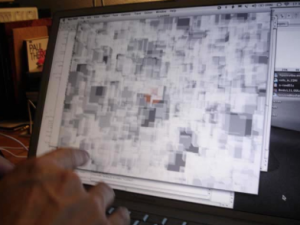“Modified Vectrex console driven by LZX Industries modular video synthesizer.”
By LZX Industries
“Modified Vectrex console driven by LZX Industries modular video synthesizer.”
By LZX Industries
With high quality texture displacement.
By Andrew Benson
A self portrait made with the Max patch below.
Download patch: hsflowdistort.zip
More from Andrew Benson:
An example by Axiom Cruz:
Optical flow, a depth camera, and edge detection.
By Matt Romein
https://cycling74.com/project/gif-portraits/
Portrait of Margo Cramer from http://mattromein.squarespace.com/#/portrait-series/
The programming uses the following external code:
jit.gl.hap – Rob Ramirez
ab.hsflow.jxs – Andrew Benson
jit.openni – DiabloDale
cv.jit – Jean-Marc Pelletier
“Boids is a bird flight and animal flock simulator. It is based on the same algorithm which was used in “Jurassic Park” for herding dinosaurs.”
Max external by Singer, Jasch, Sier and Smith. Tutorial by dude837
https://github.com/tkzic/max-projects
folder: boids
project: boids23
patch: main-tz.maxpat (slight modification to enable existing presets to work)

Audio visualization with multiple planes of video sprites in Jitter
By Andrew Benson
Recipe 6 from Jitter Recipes Book 1 https://cycling74.com/2006/02/06/jitter-recipes-book-1/
Example Output:
An increase in audio amplitude causes the video planes to dance out from the center of the display.
Patch:
Color-cycling applied to a spanning tree generated by Prim’s algorithm.
By mbostock
http://bl.ocks.org/mbostock/76da6085849bff8b6e03
“KSP is a game where the players create their own space program.”
teacher: Tom Zicarelli – http://tomzicarelli.com
You can reach me at: [email protected]
Office hours: Tuesday 1-2 PM, or Tuesday 4-5PM, at the EPD office #401 at 161 Mass Ave. Please email or call ahead.
Assignments and class notes will be posted to this blog: https://reactivemusic.net before or after the class. Search for: ep-426 to find the notes
Examples, software, links, and references demonstrated in class are available for you to use. If there is something missing from the notes, please ask about it. This is your textbook.
Syllabus:
Everybody calls this course “The Jitter class” – referring to Max/MSP jitter from Cycling 74. You will learn to use Jitter. But the object is to create interactive visual art. Jitter is one tool of many available.
The field of interactive visual art is constantly evolving.
After you take the course, you will have designed projects. You might design a new tool for other artists. You will have opportunities to solve problems. You will become familiar with how others make interactive art. You will explore the connection between sound, video, graphics, sensors, and data. You will be exposed to to a world of possibilities – which you may embrace or reject.
We will explore a range of methods and have opportunities to use them in projects. We’ll look at examples by artists – asking the question: How does that work?
Topics: (subject to change)
Grades are based on two projects that you will design – and class participation. Please see Neil Leonard’s EP-426 syllabus for details. I encourage and will give credit for: collaboration with other students, outside projects, performances, independent projects, and anything else that will foster your growth and success.
I am open to alternative projects. For example, if you want to use this course as an opportunity to develop a larger project or continue a work in progress.
https://cycling74.com/wiki/index.php?title=Max_Documentation_and_Resources